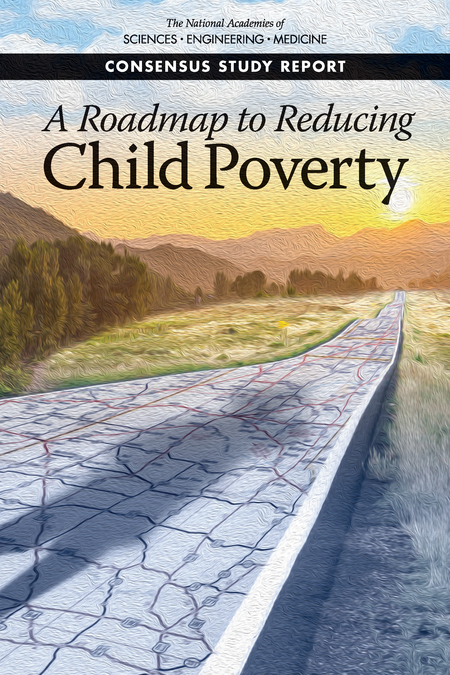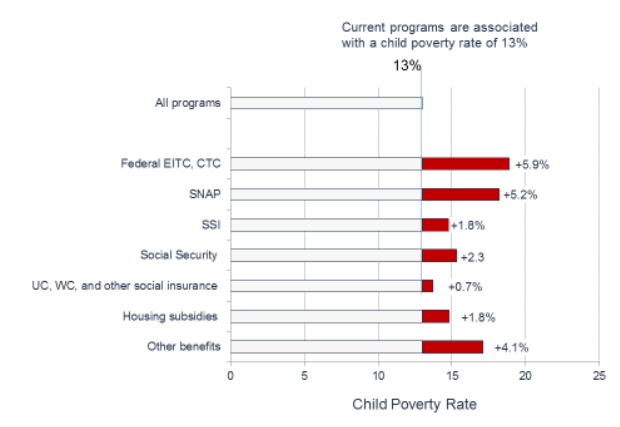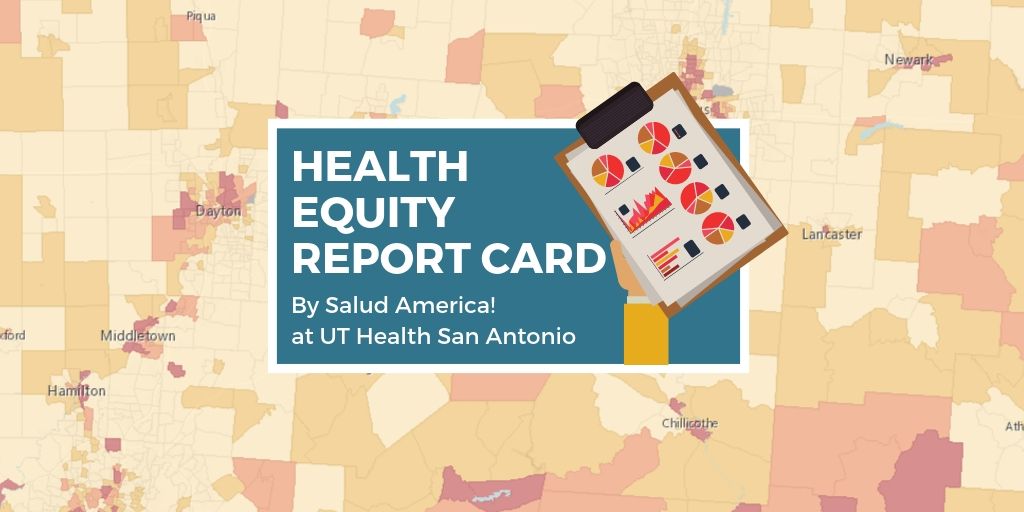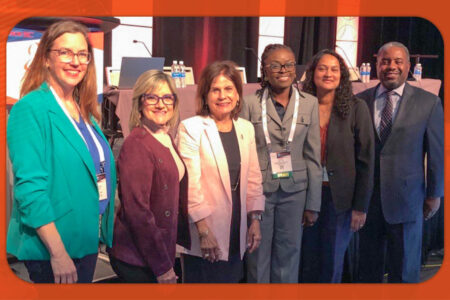Share On Social!
At least 9.6 million U.S. children (13%) live in poverty.
Among Latino children, poverty rates are even higher (22% vs. 8% white children). These children will often lack quality education and healthcare while suffering trauma and poor health outcomes.
But what if there was a way to fight poverty?
Or better yet, what if you had a road map with the most effective ways to fight poverty?
A new bipartisan report produced by the National Academy of Sciences, Engineering, and Medicine (NASEM), focuses on 10 big policy areas that could cut the child poverty rate by up to 50%, while at the same time increasing employment and earnings among adults living in low-income families.
 Researchers conducted two simulations or projections for each policy area to explore the effects that different versions of the expansion might have.
Researchers conducted two simulations or projections for each policy area to explore the effects that different versions of the expansion might have.
1. Expand the Earned Income Tax Credit (EITC)
The EITC provides a subsidy to individuals of low to moderate income and has largely been successful at reducing poverty and increasing employment among single parents.
- Option 1: Increase in payments along “flat portions of the EITC schedule.” This led to an additional 270,000 workers added to the economy, an increase of $4.9 billion in earnings, and a reduction in child poverty from 13% to 11.8%.
- Option 2: Increase EITC payments by 40% across the whole schedule. This led to an additional 541,000 workers added to the economy, $9.0 billion in earnings, and a reduction in child poverty to 10.9%.
2. Expand Child Care Subsidies
- Option 1: Expand the Child and Dependent Care Tax Credit (CDCTC) to a fully-refundable tax credit focused on families with low incomes and kids younger than 5. This led to an additional 518,000 low-income workers added to the economy, $9.3 billion in earnings, and reduced child poverty to 11.8%.
- Option 2: Provide assistance from the Child Care and Development Fund (CCDF) for eligible families with incomes less than 150% of the poverty line. This results 236,000 low-income workers added to the economy, $4.2 billion in earnings, and a reduction of poverty to 12.4%.
3. Raise the Federal Minimum Wage
- Option 1: Increase the minimum wage from $7.25 to $10.25, (with indexing to occur alongside inflation). This would lead to 42,000 lost jobs and an increase in earnings of $3.5 billion.
- Option 2: Raise the minimum wage to $10.25 or the 10th percentile of the state’s hourly wage distribution (whichever is lowest). This would increase net earnings by $1.9 billion, but lead to 28,000 in lost jobs.
4. Implement the ‘WorkAdvance’ National Training/Employment Program
These programs would make men with families and an income below 200% of the poverty line eligible for training.
- Option 1: Provide training to 10% of eligible men. This would lead to a total of 487,000 men enrolled in the program and an increase in total earnings of $817 million per year.
- Option 2: Provide training to 30% of eligible men. This would lead to a total of 487,000 men enrolled in the program, and an increase in earnings of $2.4 billion per year.
Programming would initially incur costs but ultimately lead to savings through increased earnings and tax revenues and decreased benefits from other programs.
5. Expand SNAP
Both policy options proposed would allow benefits to reach teens and address food gaps that exist during summers, when children no longer have access to school-based food.
- Option 1: Increase SNAP by 20% and adjust for children ages 12 and older (per household) and Summer Electronic Benefit Transfer to Children (SEBT). Child poverty would decrease to 11.3% (after accounting for employment effects).
- Option 2: Increase SNAP by 30% and adjust for children ages 12 and older (per household) and Summer Electronic Benefit Transfer to Children (SEBT). Child poverty would decrease to 10.7% (after accounting for employment effects).
Latino families in particular benefit from SNAP. The program lifted over 1.2 million Latino children out of poverty in 2015.
6. Grow the Housing Vouchers Program
Expansion of the Housing Choice Voucher Program would have the following effects on children:
- Option 1: Increase vouchers so that 50% of eligible families not receiving subsidized housing would use them. This would reduce child poverty to 10.9%.
- Option 2: Increase vouchers so that 70% of eligible families not receiving subsidized housing would use them. This would reduce child poverty to 10.1%.
7. Expand the Supplemental Security Income (SSI) Program
Policy options for expanding the SSI program would increase benefits to families with children and teenagers with disabilities.
- Option 1: Increase by one-third the maximum child SSI benefit (to $977 per month from a current baseline of $733).
- Option 2: Increase by two-thirds the maximum child SSI benefit (to $1,222) from a current baseline of $733).
Overall, the simulations showed little changes in child poverty with a decrease to 12.8% (including employment effects).
8. Create a Universal Child Allowance
- Option 1: Provide a monthly benefit of $166 per month ($2,000 per year) per child to families with children younger than 17 who have a Social Security number. This also calls for phasing out the child tax credit, additional child tax credit, and child allowance benefits.
- Option 2: Provide a monthly benefit of $250 per month ($3,000 per year) per child to families with kids younger than 18 who have a Social Security number. This also calls for phasing out the child tax credit, additional child tax credit, and child allowance benefits for those between 300 and 400% of the poverty line.
The first option would provide almost a universal tax credit in the form of a monthly payment. The second option would phase out benefits at lower income levels than what is established under current laws. Results from option 1 were not large enough to reduce child poverty, and option 2 reduced poverty only slightly by 0.1 percentage points.
9. Create a Child Support Assurance Program
- Option 1: Set a guaranteed minimum child support of $100 per month per child.
- Option 2: Set a guaranteed minimum child support of $150 per month per child.
Results from this analysis found that child poverty rates were not impacted by much due to the modest amounts of increases to income this would provide.
10. Increase Immigrants’ Access to Safety Net Programs
The final set of policy approaches explored expanding benefits to immigrant families.
Simulations showed minimal effects with a reduction in child poverty to 12.9% for the first policy option and 11.9% once employment effects were factored in.
- Option 1: Restore program eligibility for non-qualified legal immigrants. This option would eliminate eligibility restrictions for non-qualified parents and children in the SNAP, Temporary Assistance for Needy Families (TANF), Medicaid, SSI, and other means-tested federal programs.
- Option 2: Expand program eligibility for all non-citizen children and parents. This option would eliminate eligibility restrictions for all non-citizen parents and children in the SNAP, TANF, Medicaid, SSI and other means-tested federal programs.
A Combination Approach Works Best
Each of the 10 policies independently has the potential to help children and families out of poverty.
But the report makes it clear that no policy alone could achieve the goal of cutting poverty in half. That takes a combined approach.
Researchers went on to conduct a cost-benefit analysis for four different combinations of these policy approaches.
Of the four strategies tested in simulations, a “universal supports and work package” approach appeared to have the greatest potential to reduce both poverty and deep poverty by half. This approach would include expansion of the EITC and CDCTC, an increase in the minimum wage, increased eligibility for immigrants to safety net programs and a new child support assurance program.
It also would increase employment by 600,000 and earnings by $13.4 billion.
Consequences of Child Poverty

The report concludes that there is indeed a causal link between poverty and negative child outcomes.
Poverty during early childhood or throughout large portions of childhood is especially detrimental.
They provide recommendations for how and why communities should move forward by taking action to prevent child poverty.
Costs of Child Poverty
Researchers also found that costs associated with poverty—lost worker productivity, increased crime rates, and increased costs in health care—may amount to nearly $1.1 trillion annually.
That is 5.4% of gross domestic product.
Contrary to what many may think, the report highlights that funding social programs aimed at cutting poverty in half actually costs much less (~$90 billion) than the costs associated with child poverty.
Also, cuts to the federal earned income tax credit and child tax credit would increase child poverty by nearly 4.4 million children. Cuts to SNAP would increase poverty by up to 3.8 million children.
Solutions to ‘Deep Poverty’
Although tax credits may help some children, this does not appear to have as large of an impact on families considered to be living in “deep poverty” (an income under 50% of the poverty threshold). This is due to their already low salaries.
Access to financial assistance and SNAP have the greatest potential to alleviate deep poverty.
“Capable and healthy adults are the foundation of any well-functioning society, but because millions of American children are in families living below the poverty line, this future is not as secure as it could be,” said Greg Duncan, chair of the committee that wrote the report and distinguished professor of education at the University of California, Irvine, in a news release.
“Evidence suggests a lack of economic resources compromises children’s ability to grow and achieve in adulthood, hurting them and the broader society.”
Read a summary of the report here. The full report is also available for download here.
How Can You Help Children in Poverty Where You Are?
Start by taking a look at local health inequities.
 Download a customized Salud America! Health Equity Report Card.
Download a customized Salud America! Health Equity Report Card.
You will see how your area stacks up in poverty and other equity issues compared to your state and nation.
The you can email your report card to local leaders and share it on social media. It can be an important tool to make the case for community change to boost health equity!
GET YOUR HEALTH EQUITY REPORT CARD!
Explore More:
Understanding & Reducing PovertyBy The Numbers
23.7
percent
of Latino children are living in poverty



